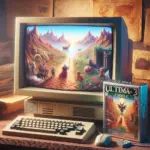The period from 2004 to 2013 was a transformative era in PC gaming, marked by groundbreaking advancements and the rise of influential games that shaped the industry’s future. This decade saw the introduction of revolutionary technologies and gaming concepts that not only enhanced the interactive experience but also expanded the scope and reach of PC gaming to a broader audience. From the introduction of physics engines that changed the way we interact with game worlds to the establishment of digital distribution platforms that revolutionized game purchasing and delivery, this era was pivotal in making PC gaming the dynamic and diverse platform it is today.
Half-Life 2 (November 2004)
(Image credit: Valve)
Half-Life 2 was a monumental release in PC gaming, setting new standards for the industry with its advanced physics engine, detailed environments, and immersive storytelling. The game’s realistic, contiguous 3D world and the ability to interact with nearly every object set a new benchmark for what gamers could expect from a first-person shooter. The narrative, driven by lifelike characters and a compelling plot, elevated the gaming experience to cinematic heights.
More than just a critical success, Half-Life 2 was instrumental in the rise of Steam, Valve’s digital distribution service. The game’s requirement for Steam installation introduced millions of players to the platform, which has since become the leading digital distribution platform for PC gaming. This move by Valve was a significant step towards the digital future of game distribution, making Half-Life 2 not just a game-changer in a literal sense, but also a catalyst for industry-wide transformation.
World of Warcraft (November 2004)
The release of World of Warcraft (WoW) marked a defining moment in the massively multiplayer online (MMO) genre. Blizzard Entertainment’s foray into the MMO market not only captured the imagination of gamers worldwide but also set a new standard for the genre. WoW’s approachable gameplay, captivating world, and social dynamics made it an instant classic, attracting millions of players and maintaining a dominant position in the market for years.
WoW’s success was so profound that it effectively ended the MMO craze of the 2000s by setting a bar that few could reach. Its influence extended beyond its own genre, impacting game design principles across various types of games. The game’s lenient death penalty, intuitive auction house system, and engaging PvP content were among the many features that other developers sought to emulate.
Even as the MMO landscape evolved, World of Warcraft continued to innovate and reinvent itself with expansions that added new content and overhauled existing systems. The game’s enduring popularity led to the release of WoW Classic, allowing players to experience the game as it was at launch, further cementing its legacy as one of the most influential PC games of all time.
Oblivion’s Horse Armour (April 2006)
The release of the horse armour DLC for The Elder Scrolls IV: Oblivion sparked a significant controversy that would shape the future of in-game purchases. This seemingly innocuous cosmetic upgrade became a symbol of the industry’s shift towards microtransactions and downloadable content (DLC).
- Initial backlash over perceived value of DLC
- Shift from substantial content packs to smaller, often cosmetic, purchasable items
- Gradual acceptance and normalization of microtransactions in gaming
Today, the concept of paying for in-game items, such as skins, weapons, or even character outfits, has become commonplace. The initial resistance to Oblivion’s horse armour paved the way for a wide array of monetization strategies, including loot boxes, season passes, and battle passes, which are now standard in many games.
Dwarf Fortress (August 2006)
Dwarf Fortress stands as a testament to the depth and complexity that a management sim can achieve. Released by Bay12 Games, this title was a trailblazer with its intricate simulation of a procedurally generated world. Dwarf Fortress tasked players with building a thriving settlement for a group of dwarves, managing every aspect of their lives, from their individual personalities to the ecosystem of the world they inhabit.
The game’s ASCII graphics belied the complexity within, offering a level of detail and depth that influenced a generation of games. Dwarf Fortress’s legacy can be seen in the rise of other successful management sims and colony builders, such as Prison Architect and RimWorld, which owe a great deal to the pioneering work of Dwarf Fortress.
The Orange Box (October 2007)
Valve’s The Orange Box was an unprecedented compilation that bundled together Half-Life 2: Episode Two, Team Fortress 2, and the innovative puzzle game Portal. This collection was not only a fantastic deal but also a showcase of Valve’s diverse development prowess.
While Half-Life 2: Episode Two continued the beloved series’ story, Team Fortress 2 broke new ground with its stylized graphics and class-based multiplayer action. However, it was Portal that became the surprise hit, introducing players to the mind-bending mechanics of portal traversal and the unforgettable character of GLaDOS.
The impact of The Orange Box was profound, influencing the way games could be packaged and sold. It also demonstrated the potential for smaller, experimental games to receive mainstream attention when paired with more established titles.
Plants vs Zombies (May 2009)
Plants vs Zombies played a pivotal role in bringing casual games to the forefront of PC gaming. Developed by PopCap Games, this charming and addictive strategy game showcased that casual titles could stand alongside more traditional PC games in terms of popularity and profitability.
Following its success, Plants vs Zombies transitioned to mobile gaming, where it found an even larger audience. Its influence on the casual game market is undeniable, proving that games with simple mechanics can have a significant impact and broad appeal.
Recettear: An Item Shop’s Tale (September 2010)
Recettear: An Item Shop’s Tale marked a significant milestone as the first Japanese game to be released on Steam, paving the way for a more diverse range of games on the platform. This charming role-playing game, which combines dungeon crawling with shop management, opened the door for other Japanese developers to bring their games to a global audience through Steam.
The success of Recettear on Steam demonstrated the platform’s reach and its potential to support games from all over the world, leading to an influx of Japanese titles in the years that followed. This included major franchises and beloved series, significantly enriching the variety of games available to PC gamers.
Minecraft (November 2011)
The official release of Minecraft in November 2011 was the culmination of a highly publicized alpha and beta phase that had already cemented the game’s status as a cultural phenomenon. Developed by Mojang, Minecraft was revolutionary for its open-ended gameplay, allowing players to build, explore, and survive in a procedurally generated world made entirely of blocks.
The game’s development process was equally groundbreaking, engaging with the community in an ongoing dialogue that shaped the game’s evolution. This approach laid the groundwork for what would become known as Early Access, a model that allows players to buy and play games while they are still in development, providing valuable feedback to the creators.
Minecraft also had a profound impact on the types of games being developed, inspiring a new genre of survival games and influencing titles across various categories with its crafting and building mechanics. Its legacy continues to shape the gaming landscape, with its influence seen in countless games that followed.
The Elder Scrolls V: Skyrim (November 2011)
(Image credit: Bethesda)
The Elder Scrolls V: Skyrim is often hailed as Bethesda’s magnum opus, a game that combined the depth of its predecessors with a more accessible open world ripe for exploration. Drawing inspiration from Norse mythology, Skyrim’s landscape was a departure from the typical fantasy setting, offering a world filled with rugged mountains, ancient dragons, and a rich tapestry of lore.
The game’s success was not just due to its immersive world, but also to its modding community. The robust support for user-created mods has extended the life of the game far beyond its initial release, with players continuously adding new content, enhancements, and fixes. This has kept the game fresh and relevant, contributing to its enduring popularity and status as a cultural icon in gaming.
For many, Skyrim represents the pinnacle of the role-playing genre, a title that has influenced countless other games and spawned a community dedicated to keeping the world of Tamriel alive. Its impact on gaming culture cannot be overstated, with its catchphrases and memes permeating the internet and its gameplay mechanics influencing a generation of RPGs.
XCOM: Enemy Unknown (October 2012)
The release of XCOM: Enemy Unknown by Firaxis Games marked a significant turning point for the turn-based tactics genre. This modern reimagining of the classic 1994 game X-COM: UFO Defense brought with it a renewed interest in strategic gameplay that required careful planning and consideration with every move.
XCOM: Enemy Unknown combined a high-stakes alien threat with deep tactical gameplay and permadeath mechanics, creating a tense and challenging experience that resonated with players. Its success revitalized the genre, inspiring a new wave of turn-based strategy games and influencing titles across various platforms.
The game’s blend of base management, squad customization, and nail-biting combat encounters set a new standard for what a modern strategy game could be. It’s a testament to the enduring appeal of turn-based tactics and a blueprint for the genre’s future.
Steam Early Access Starts (March 2013)
The introduction of Steam Early Access in March 2013 was a game-changer for the industry, allowing developers to sell and continue to develop their games while engaging with a community of players. This model provided a new way for developers to fund their projects and gather valuable feedback during the development process.
| Early Access Title | Outcome |
|---|---|
| Kerbal Space Program | Full Launch, Acclaimed Success |
| Prison Architect | Full Launch, Strong Sales |
| ArmA 3 | Full Launch, Continued Popularity |
While there were concerns about the potential for abuse, the overall impact of Steam Early Access has been positive, with many games reaching full release and achieving critical and commercial success. It has become a staple of the PC gaming ecosystem, providing a platform for innovation and collaboration between developers and players.
Oculus Rift DK1 (March 2013)
(Image credit: Oculus)
The arrival of the Oculus Rift Developer’s Kit 1 (DK1) marked a significant milestone in the evolution of virtual reality, offering a glimpse into the future of immersive gaming. Despite its early-stage technology, the DK1 provided developers and enthusiasts with the first accessible means to experiment with VR environments.
While the DK1 had its limitations, such as lower resolution and motion sickness for some users, it was a crucial step in bringing VR into the mainstream conversation. The potential for a fully immersive gaming experience was now tangible, and the excitement around VR began to build.
Since the release of the Oculus Rift DK1, VR has become an established niche within PC gaming, with titles like Half-Life: Alyx pushing the boundaries of what’s possible in virtual worlds. The DK1’s legacy is seen in the ongoing development of VR technology, which continues to strive towards more realistic and comfortable experiences for players.












